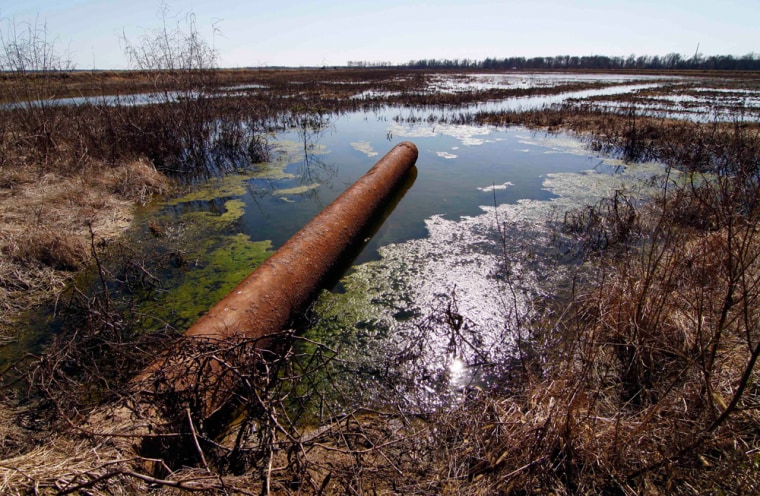Pond scum was once an aquatic nuisance that Hall Barret III once hated to see in his catfish ponds.
It just might become his next cash cow.
After more than 30 years, Barret is giving up catfish and becoming a landlord of algae. And he's hoping his lease agreement with PetroSun BioFuels Inc. pays him huge royalties.
The Scottsdale, Ariz.-based company wants to convert Barret's catfish ponds into an algae farm to produce alternative fuel, paying the owner of B&B Fish Farm thousands of dollars to baby-sit the new and unusual crop.
"Never in my wildest dreams would I have ever thought that I would be doing this," said Barret, who for decades has operated the Mississippi Delta fish farm with his sister Liz Jordan near Belzoni, known as the Catfish Capital of the World.
Barret and Jordan have agreed to lease their old catfish ponds to PetroSun to grow algae used in the production of biodiesel, ethanol, and livestock feed.
The company plans to begin algae-to-biofuel operations after obtaining permits from the Department of Environmental Quality and other state agencies. Former catfish farm employees would help harvest the algae.
About 95 percent of the nation's catfish are produced on farms in Mississippi and the three neighboring states, in one of the nation's poorest regions.
Barret and his employees once battled the blue-green plantlike organism that can taint farm-raised catfish with a musty off-flavor and cost farmers time and money. That wild algae is not fit for production, but PetroSun says it can grow some suitable for alternative fuel.
Terri Chiang, an authorized agent for PetroSun BioFuels, has been introducing the lease program to state officials and catfish farmers in Mississippi, Arkansas, Louisiana, and Alabama. She said it's like an oil and gas lease.
"We have given the landlord the opportunity to participate on all products that are produced on their property," Chiang said. "So initially, we have arranged for the landowner to receive $50 per water acre signed into the program as a sign-up, one-time payment. Additionally, the landlord will receive advance base rent payments at the beginning of every year of $100 (per acre)."
The real money for farmers would be the monthly royalties. For Barret and Jordan, who own 744 water acres, royalties could mean between $744,000 and $892,800 a year, based on PetroSun's formula.
However, there are skeptics.
Tom Konrad, a regulatory consultant and financial analyst for AltEnergyStocks.com, says PetroSun's idea of harvesting algae in open ponds isn't feasible.
"I believe that you can never economically produce algae for biofuel by that method," he said.
Konrad said it has been produced in closed environments where there are fewer challenges to harvesting.
PetroSun, a diversified energy company founded in 2001 by Gordon M. LeBlanc Jr., would not reveal the details of its algae growing methods.
Tom Byrne, a Minnesota-based renewable energy consultant and member of the Algal Biomass Organization, said companies researching algae-to-biofuel technology are looking at ponds because bio reactors are expensive.
Another challenge he said, is separating water from the algae.
"Algae isn't something you can just run through a filter," he said. "It is not easy to de-water once you really start working with it, so that's ... the bottleneck."
If the capital cost drops and the de-watering technology improves, Byrne said, aviation and the military could become viable markets for algae-based fuel. He predicts it will take five to 10 years before the industry makes a real difference.
"Which is faster than you can drill off the coast," he said.
Andy Whittington, president of the Mississippi Biomass and Renewable Energy Council, supports the PetroSun project.
"Algae-to-biofuels has a real chance to be successful and generate significant income for these farms," Whittington said.
He said revenue could potentially come from algae oil for biodiesel, cellulosic ethanol from the leftover algaecake, and a livestock feed additive from the residuals.
Catfish farmers have been suffering because of the rising cost of fish feed, fuel, and the influx of foreign fish into their market.
U.S. catfish growers had sales of $409 million in 2008, down 8 percent from the previous year. Sales have dropped 16 percent since 2006, according to USDA statistics.
"Right now the opportunity to grow algae is an option for these farmers," said Paul S. Chamblee, aquaculture coordinator for Mississippi Farm Bureau Federation. "If catfish farmers have an opportunity to make more money by changing crops, they will."
